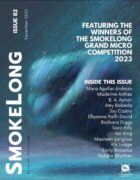Your imagery is striking, but I was especially fond of an early, visceral description of Taylor peeling away layers of her face. Similarly, I think the line spoken by Taylor about wanting to feel less shiny is fascinating. Can you speak on these two moments, how (if) they connect with each other and what this means for the narrator?
I’m happy to hear these lines stood out to you because they were the genesis of the story. Taylor has been coming to me in dreams when I visit my sick mother. In one dream, she ripped off her own face. Why would my subconscious want Taylor to do this? Why would Taylor want to do it? Maybe she wishes to return to her younger self? To somehow improve herself? Or maybe she wishes to destroy herself or the image we have of her? To shed her humanity? Her shine? To leave something behind? I don’t know!
I wanted Taylor’s presence to feel both otherworldly and corporeal. Peeling her face away reminds the reader of the gruesome elements of even the most perfect body—the flesh, the aging skin cell. But there is also something Shroud-of-Turin about this moment. My story offers up the mother’s True Cross in contrast to the near cult-like status of Taylor Swift, venerated like a goddess on today’s giant stages. The narrator seeks the joy and wonderment this goddess offers, but for my Taylor character, her own shininess is a burden from which she craves respite.
These characters really come off the page—what was your strategy for each relationship? Did anything surprise you?
Thank you! I originally pictured “Deliver Us” as a poem expressing emotional states. So, I felt these characters before I had a plot for them. The more I wrote, the more narrative the work became and the more the relationships took shape. My writing process is one of layering. I added and subtracted brushstrokes until the relationships were fully in motion, working in two directions—meaning each participant wanted something and got/lost something, each character had a little sweet and a little salt.
Discovering the mother’s irreverence for Taylor was a fun surprise to me. When people are ill, they can be quite irritable and impatient, but they can also see through to the beautiful heart of things. I initially envisioned Taylor arriving as a balm to this house. But, instead, she is a disruptor. She has mud on her boots. The narrator ends up having to take care of Taylor, too—drawing her bath, protecting her from the world with blackout shades, propping her on pillows. The tenderness the narrator feels toward Taylor was also a lovely surprise to me.
Though the narrator and mother feel displaced in much of the story, readers are left with hope, found in the wildflowers at the end. What do you believe the narrator sees in the flowers?
In moments of pain and illness, the world becomes intensely bleak. Everything is a state of decay; color vanishes. And, yet, in this darkness, out of nowhere, humans often experience euphoric moments of wonder, of rebirth. And when we do, it is so shocking it stops us in our tracks. How can there be beauty at a time like this? It is often nature or art or religion that deliver these moments to us. They connect us back to something deeper than just the one clump of flowers on a berm or a single singer on a stage. Moments of wonder connect us to all humans who have ever seen a flower and felt their hearts swell, to our grandmothers before us who experienced this joy and revelation, and to everyone who will be born after us. I think my characters feel the embrace and collapse of time, of the cycles of life, in these flowers.
Your details feel so intentional—how did you choose which songs of Taylor Swift’s to include, and were there any you wanted to mention, but didn’t?
Confession: I listened to Taylor Swift on walks for weeks while writing this story, trying to decide songs! Apple Music tells me I listened to 1504 minutes of Taylor this year. “Marjorie” was easy; it connects Taylor to the experience my narrator is having—mourning the loss of a maternal figure. Invoking those lyrics lets the reader know that Taylor arrives to the story in grief without my ever having to say it. I love how a song can do that. Similarly, “Lavender Haze” conjures the 1950s bride, something I imagine the narrator’s mother to have been but don’t ever mention. I did struggle over which song to use in the ending. I tried so many I don’t even remember them all. The story was born of emotion and dream, so I wanted a song that we feel in our bodies more than understand in our minds, that echoes the vibrance and mystery of the flowers, the haze of grief.
On Halloween, I saw a child dressed as Taylor in a monstruous fuzzy lavender jacket and sparkling lavender dress. I thought, “Yes! That is exactly what my story would wear.”
Is there another layer to what your characters are being delivered from? Is there something you hope readers can be delivered from, on their behalf?
In writing this story, I pictured the reader, myself, and the characters squeezing through a birth canal to some other side. Do I know what that side is? No. But I feel the squeeze of the vagina, of the underground tunnel that births us onto stage, of the portal that delivers us from ungodly pain. The story is steeped in the Catholicism that sustains my own mother now during catastrophic illness. Deliver us from evil. I heard this phrase over and over as I wrote the story. I saw cancer, war, fame, McMansions, mud, Oxycontin, the cross, but also—the soft swaths of pastel fabric, the tiny purple blooms on a grandmother’s skirt.


